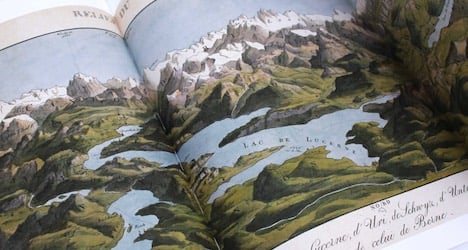The company was started by Hadi Barkat, an Algerian expat who launched a board game called Helvetiq that tests your general knowledge of Switzerland — the kinds of things you need to know to become a Swiss citizen.
Launched in 2008 as a hobby by the computer science graduate of the Federal Institute of Technology at Lausanne (EPFL), the game was an instant success.
Available in Switzerland’s three official languages, as well as in English, it spawned other products under the Helvetiq name.
Continuing with the same theme, Helvetiq’s latest English-language offerings offer more fun ways to find out things about Switzerland you may not already know.
Among them is Around Switzerland in 80 Maps, a lavishly illustrated cartographic survey of the country by British expat writer Diccon Bewes.
After scouring the maps section of Zurich’s Central Library and researching multiple other sources, Bewes offers what he calls a “magical journey” through more than 500 years of Swiss map making.
Starting with the earliest known map, a primitive illustration to a Latin text from 1480, Bewes takes us on a tour of the topsy turvy early charts, oriented to the south at the top.
The challenge of the early cartographers was to delineate, without much in the way of technology, the mountains, valleys, rivers, lakes and human settlements of the Swiss region as accurately as possible.
Switzerland as we know it today dates only from 1815 and before that it consisted of a loose federation of states centred around the founding cantons.
Bewes, author of other books about Switzerland (Swiss Watching and Slow Train to Switzerland) uses maps to sketch the country’s history and also to look at how different cities and regions developed.
The largest section is devoted to tracing the development of Swiss tourism and its transport system, from cog railways to mountain cable cars.
The book also features maps used to illustrate different aspects of Swiss culture from cheese and watches to cows.
There’s even a fantasy section devoted to plans for the country that didn’t pan out — from a high-speed metro line to a proposal to divide Switzerland into 40 cantons (up from the current 26).
In a foreword to the 223-page book, Thomas Schulz, president of the Swiss Society of Cartography, notes that it marks a first.
“No one else ever came up with the idea of taking a popular visual journey through more than 500 years of the rich tradition of Swiss maps,” he writes.
“Maybe it really did just need the celebrated ‘outsider perspective’ , as well as the carefree curiosity of an Englishman who has lived in and travelled around Switzerland for many years.”
Someone who became adept at reading a map, Monika Saxer, has written another guide promising “the most refreshing way to discover Switzerland”.
Her Beer Hiking Switzerland offers routes for 59 scenic hikes that end near a brewery or a bistro where you can quench your thirst with a local Swiss brew.
Saxer, a certified Swiss Alpine Club mountain guide from Zurich, normally sets off on her jaunts with a litre and half of tea in her backpack (she could pass for a Brit for that). But she is still thirsty enough for a beer at the end of the trail.
She was initially inspired by the idea of hiking toward a destination with a tasty beer as a reward by an article about the Fischerstube, a new microbrewery opening in Basel.
She figured out a route for an interesting route to the brewery, which was the precursor of many other small craft breweries that sprang up across Switzerland.
“From time to time I heard about the opening of a new brewery and I imagined a new hike to get there.”
Saxer started compiling hikes to breweries online and an interview with a magazine caught the attention of Helvetiq, who suggested putting together a book.
Her hikes vary from one to six hours, ranging in difficulty from easy walks to more challenging hikes and Alpine rambles.
She gives starting points, provides references for detailed maps, notes interesting sights, gives an estimate of the time for hiking and identifies climbs and descents in elevation, as well as return routes.
One thing that quickly becomes clear, apart for the variety of places to hike, is the multitude of different kinds of beer on offer in various parts of the country.
As a section in the book of interesting facts points out, Switzerland has more than 480 registered breweries, which puts it in the world’s top ten on a per capita basis.
Saxer describes the beers according to such factors as their bitterness, sweetness, colour and alcoholic content.
The hikes aren’t always in the pastoral places you might imagine.
The guide starts with a hike from the Zurich airport to a hotel where you can quaff Zurich Airport Beer, described as non-filtered, naturally dark and top fermented with a 5.8 percent alcohol content.
The book is designed both for lovers of beer and energetic strolling.
As a blurb on the fly cover puts it: “If beer is not your thing, the hikes are unique and the landscape is breathtaking. If you would rather focus on the beer, all breweries in the book are also reachable by car.”
To round your knowledge of Swiss geography, Helvetiq has devised another board game, Grand Tour Switzerland.
Created by Helvetiq founder Barkat and colleague Sebastien Pauchon, it challenges your knowledge of the country with such questions as “Which cantons sit on the banks of Lake Murten?” or “The headquarters of Mövenpick is located in which Swiss canton?”
By the time you’ve played this game a few times, enjoyed the beer hikes and scrutinized the 80 maps selected by Bewes, you should be eligible, if there were such a thing, for honorary Swiss citizenship.
For more information, check the Helvetiq website.


 Please whitelist us to continue reading.
Please whitelist us to continue reading.
Member comments